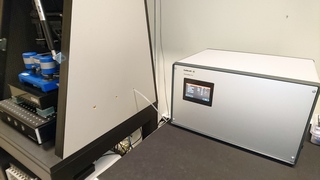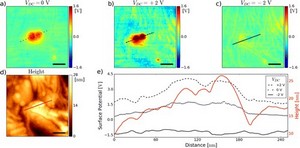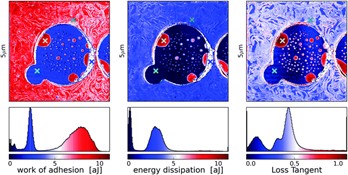September 2016 Newsletter
Albanova Nanofabrication Facility AFM Lab
Recent developments from the AFM lab in the Albanova Nanofabrication Facility includes a new controller for inline humidity, new methods for surface potential mapping with controlled DC-bias and analysis of rheological properties of soft materials. There are also some promising new probes on the way, and finally a list of recent publications. Enjoy!
Humidity control

An in-line system for humidity control has been purchased from Stockholm-based CellKraft AB. This system provides the ability to control relative humidity between 0 and 100% at temperatures up to 50°C. The flow-rate can be controlled, and is quite low to avoid the effect of turbulence on the cantilever during measurement. It is currently attached to the JPK UltraSpeed system, but it can also be attached to the Bruker Icon together with the Heater-Cooler stage. Initial measurements have been performed on the mechanical properties of hydrogels at varying humidity, and the results are promising!
Examples of applications could include:
- atmospheric corrosion
- properties of wood and cellulose-based composites in varying environmental conditions
- hydrogel hydration (e.g. for contact lenses)
Surface potential measurements at varied DC-bias

An intermodulation-based method has been developed to allow, for the first time, determination of surface potential under an applied DC bias ( link to article ). This allows e.g. planting of charge at different tip-bias and subsequent observation of its dissipation on an insulating or semi-conducting sample. The method has been developed by Riccardo Borgani of the Section for Nanostructure Physics. the intermodulation based method provides an inherently high sensitivity of potential determination as the mixing peaks are amplified by their proximity to the resonance peak, thus greatly improving signal-to-noise ratio. This is in contrast to KPFM (SKPM) where the intensity of the mixing peak is minimized away from resonance.
Moving surface model for rheological characterization of soft materials

“Standard” AFM-based methods for determining mechanical properties suffer from some significant limitations. The most serious of these is that the behaviour of the tip-surface system under the influence of an attractive force is not well accounted for. A new model currently under development in the group of David Haviland is starting to provide solutions to this limitation ( link to article ). It provides not only stiffness but also viscosity/dissipation/loss tangent of the surface. The method is simulation-based and requires considerable computer power, so it is currently being applied to a limited range of applications, but should become more generally available as it develops. Watch this space!
Probe News
Sharp conducting single-crystal diamond probes -A major problem with metal coated probes for measurement of conductivity or surface potential, is that the coating is easily damaged by asperities on the surface during measurement, and the minimum radius is limited by the thickness of the metal coating to around 30nm. Adama Innovations Ltd. based in Dublin ( www.adama.tips ), produce single crystal probes with diameters as low as 5nm. While they are relatively expensive, their extreme hardness should ensure very good wear resistance. We have ordered a few probes and will test them for surface potential measurement.
Supersharp Peak Force Tapping probes for imaging of biomolecular structure in liquid - Bruker have just released two new probes for high resolution imaging of biomolecules (e.g. DNA/proteins) in liquid ( link ). The probes have a nominal radius of 1nm and are able to clearly differentiate major and minor grooves in DNA. I should have probes for testing shortly if anyone is interested.
Some recent publications from work performed in the Nanolab AFM laboratory
Hydrophobisation of wood surfaces by combining liquid flame spray (LFS) and plasma treatment: dynamic wetting properties, Moghaddam, Maziar Sedighi et al, Holzforschung, 70, 6, 527-537, 2016
Wetting hysteresis induced by temperature changes: supercooled water on hydrophobic surfaces, Heydari, Golrokh et al, Journal of Colloid and Interface Science, 468, 21-33, 2015
Experimental and computational assessment of f-actin influence in regulating cellular stiffness and relaxation behaviour of fibroblasts, Fallqvist, Björn et al, Journal of the mechanical behavior of biomedical materials, 59, 168-184, 2016
Towards the mechanism of electrochemical activity and self-healing of 1 wt% PTSA doped polyaniline in alkyd composite polymer coating: combined AFM-based studies, Li, Jing et al, RSC Advances, 6, 23, 19111-19127, 2016
New method for lateral mapping of bimolecular recombination in thin‐film organic solar cells, Bergqvist, Jonas et al, Progress in Photovoltaics: Research and Applications, 2016
A virtual instrument to standardise the calibration of atomic force microscope cantilevers, Sader, John E et al, arXiv preprint arXiv:1605.07750, 2016
Retention of Electronic Conductivity in LaAlO3/SrTiO3 Nanostructures Using a SrCuO2 Capping Layer, Aurino, PP et al, Physical Review Applied, 6, 2, 24011, 2016
Imaging high-speed friction at the nanometer scale, Thorén, Per-Anders et al, arXiv preprint arXiv:1601.07693, 2016
